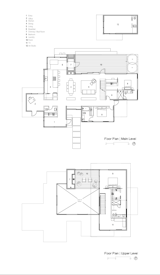A Net-Zero Home in Colorado Raises the Bar for Indoor/Outdoor Living
A decade ago, interior designer Stephanie Waddell moved with her husband and young son into an aging ranch house in the foothills of Colorado’s Rocky Mountains. Located on a leafy road in the city of Boulder, the single-story house, which dates to 1948, was rather dark and cramped, but the family made the most of it. By 2017, however, the time had come to update the 1,750-square-foot dwelling. "We definitely needed a little more space," says Stephanie, who leads local studio Istoria Interior Design.
For help in creating her new family home, she turned to close friend Renée del Gaudio of Renée del Gaudio Architecture, a Boulder-based firm that focuses on site-specific design. Among the firm’s award-winning projects is del Gaudio’s own home, Sunshine Canyon House, a rustic yet modern abode that embraces the natural landscape.
For her friend’s dwelling, del Gaudio wanted to create "a house of gardens and light." To achieve this, she conceived a drastic plan: raze the original house, but preserve its irregular, blocky footprint, which steps around little pockets of greenery. "The redeeming quality of the house was its footprint—the twists and turns the exterior walls took in relation to the landscape on the property," says del Gaudio. "The original foundation was not so much a constraint as a real opportunity."
And so, the 70-year-old ranch house came down, and atop the existing concrete foundation rose the Mariposa Garden House: a two-level, 3,150-square-foot building comprising rectilinear volumes with ample glazing, flat roof planes, and a series of surrounding gardens with outdoor spaces. (The materials from the tear down, it should be noted, were donated to recycling organizations.)
To build the home, del Gaudio implemented a new timber frame and membrane roof, and installed energy-efficient walls. In the rear of the building, the team erected a tall brick "chimney volume" to accommodate two fireplaces, one for each level. The vertical masonry form also holds a compact mudroom on the first floor.
The facades are clad in ebony-stained cedar, a material that further grounds the house to the land, del Gaudio explains. Cedar was also used for the roof eaves. A variety of glazed apertures—from generous picture windows to long clerestories—usher in daylight and open the home up to its surroundings.
Inside are lofty rooms and a fluid layout. The main level encompasses an office, two bedrooms, and an open-plan living area, along with a separate art studio to the back of the lot. The upper level, envisioned as a "nest in the trees," holds a master suite. Despite having a partial second level, the residence appears low to the ground, much like the original house. "We didn’t want to build anything massing-wise that would obstruct views," says del Gaudio.
Providing opportunities for indoor/outdoor living was an important aspect of the project. In turn, the design team incorporated a 16-foot-wide sliding glass door in the living room, which enables the space to seamlessly merge with a large covered patio.
Stylish patio furniture and a built-in grill help establish the perfect setting for the family to entertain guests or have a casual dinner. Beyond the patio is a fire pit, which sits among quaking aspen trees and other native vegetation.
The home’s upper level also affords the family a strong connection to the outdoors. The master bedroom flows onto a glass-lined terrace overlooking the backyard; a fireplace permits year-round use of the open-air space. "Stephanie has these heated chairs out there that we’ve been sitting in throughout the winter," says del Gaudio. "It’s just this really cozy, private space."
Creating a comfortable and inviting atmosphere was Stephanie’s guiding principle for the house, but especially the interiors, where she put her professional talents to work in spite of the challenges. "Working on my own house was very stressful," she laughs. "I don't know if I'd ever do it again."
Throughout the dwelling are contemporary and vintage pieces in a range of hues, textures, and patterns. Earthy elements—like walnut cabinetry, stone tile, slate countertops, and leather upholstery—help the home feel warm and approachable.
"I hate the idea of anyone being intimidated by my home, or worried that they’re going to break something," says Waddell. "It’s one of the reasons I purchase vintage decor: If it gets bumped, or if there’s a spill on the rug, it becomes part of the piece’s history."
Another key concern for Stephanie and her was environmental responsibility. Beyond a super air-tight building envelope, the house has an abundance of sustainable elements. These include a high-efficiency boiler, in-slab radiant heating, charging outlets for electric vehicles, and LED lighting throughout.
The residence is net-zero thanks to an eight-kilowatt photovoltaic array (with inverters) on the roof. The preservation of the former home’s footprint, which helped reduce material usage and waste, also counts among the project’s environmental merits.
Plus, the footprint helps connect the new home to its predecessor, where Stephanie and her family lived happily for years."They loved living in the original house," said del Gaudio. "By using its foundation, we’ve tied the house to its past."
Related Reading:
A Low-Slung Lake House in Texas Merges Indoor/Outdoor Living
A Sleek Monochromatic Home Strikes Harmony With Colorado’s Rugged Mountains
Project Credits:
Architect of Record: Renée del Gaudio Architecture / @reneedelgaudioarchitecture
Builder/General Contractor: Coburn Development / @coburn_dev
Structural Engineer: Anthem Structural Engineering
Landscape Design: Marpa Landscape Architecture / @marpalandscapes
Interior and Lighting Design: Istoria Interior Design / @istoriainteriors
Cabinetry Design/Installation: Kitchens by Wedgewood
Published
Last Updated
Get the Dwell Newsletter
Be the first to see our latest home tours, design news, and more.


















